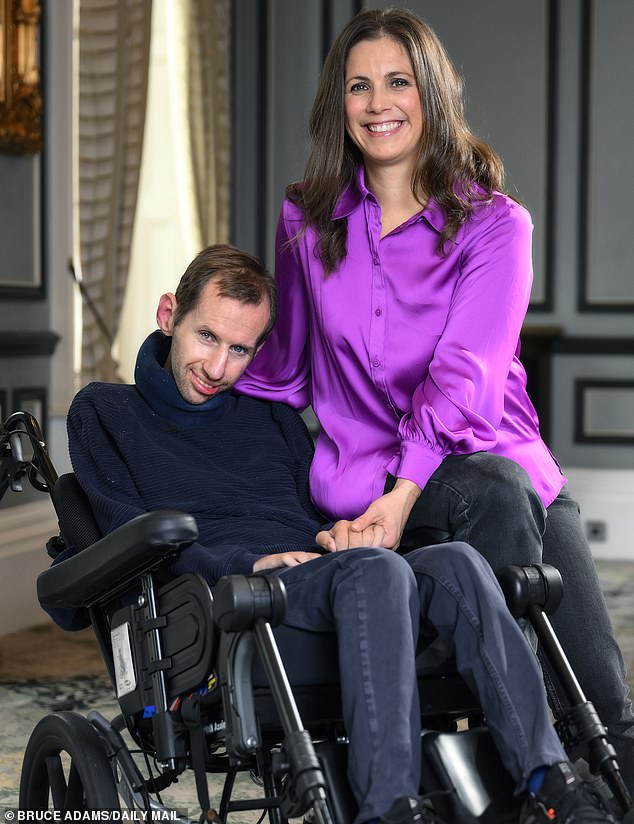The sport I’d NEVER let my children play, by a leading brain doctor – who says it’s as bad as being in a car crash and there’s NO safe way to take part





Fast-paced and dynamic, rugby – which started out on English public school playing fields in the 19th century and became a professional sport in 1995 – is as popular as ever.
More than 220,000 people in England alone play rugby union, according to government figures – many more if you include rugby league.
Traditionally a male sport, rugby’s popularity has recently surged among girls and women too: the numbers playing shot up more than 60 per cent from 25,000 to 40,000 between 2017 and 2022, according to Sports England.
But the undoubted benefits of rugby – including encouraging teamwork and boosting fitness, stamina and discipline – are now also increasingly being set against emerging health risks.
There are, on average, almost three (2.6) injuries per match, according to the annual review of injury surveillance research in elite rugby union in 2023.
And injuries occur at every level of the sport. Analysis of 800 adolescents who played rugby at school found that one in three sustained an injury as a result, half of which were so serious that they could not play rugby again for a month or more, according to 2017 research published in the British Journal of Sports Medicine.

Following the recent tragic premature death of rugby league star Rob Burrow at the age of 41 (pictured with wife Lindsey), the spotlight is once again on the apparent link between rugby and chronic brain injuries
Cauliflower ears, broken noses, sprains, breaks and lacerations are common in a sport that puts huge demands on the body.
But less visible injuries could be doing far worse long-term damage.
Repeated concussions, which have been linked to conditions such as early-onset dementia, made up 24 per cent of match injuries in 2021-2022.
Following the recent tragic premature death of rugby league star Rob Burrow at the age of 41 – four-and-a-half years after he was diagnosed with rare and incurable motor neurone disease (MND) – the spotlight is once again on the apparent link between rugby and chronic brain injuries.
Burrow, who played for Leeds Rhinos and represented England and Great Britain, was diagnosed with MND in 2019, just two years after retiring from a stellar 17-season career.
His diagnosis was not conclusively linked with playing rugby, but a 2022 University of Glasgow study of 412 male international players found they had more than double the risk of developing neurodegenerative diseases – such as MND – than a non-player.
And one of the largest studies of its kind, published last year in the journal Amyotrophic Lateral Sclerosis and Frontotemporal Degeneration, found sports with repetitive trauma involving the spine and head – such as boxing and rugby – were linked to a greater risk of MND.
‘There’s lots of work going on to try t establish if the two are connected, but it is not conclusive by any means,’ says Dr Nick Cole, head of research at the MND Association.
While the link between MND and rugby is inconclusive, adds Dr Keith Parry, head of the department of sport and event management at Bournemouth University and co-founder of the Acquired Brain Injury Research Network, tackling in rugby does harm the brain, he says.

Dr Parry played for his university team while he was studying at Warwick but insists his own eight-year-old son will not be following in his footsteps, at least until he’s 18
‘We know that any blows to the head caused by impact can lead to an increase in neurodegenerative diseases such as traumatic encephalopathy syndrome.’
This is where nerve cells in the brain die as a result of repeated head impacts. It is thought to raise the risk of dementia and other neurological problems.
‘It doesn’t have to be a single big impact either or cause loss of consciousness – lots of smaller traumas, which don’t necessarily count as concussions, over time can cause long term cognitive decline,’ says Dr Parry.
In December 2020, former England rugby union players Steve Thompson and Michael Lipman, and former Wales No 8 Alix Popham, announced they all had early-onset dementia and chronic traumatic encephalopathy.
In a typical rugby game, there may be hundreds of collisions as players battle to get control over the ball.
One study, published in Experimental Physiology in 2021, suggests professional rugby players may be exposed to 11,000 contacts per season, consisting of tackles, collisions, mauls and rucks.
The sport’s governing body, World Rugby, says player safety is now a top priority.
It’s introduced changes for professional players in training – including limiting full-contact training to 15 minutes a week – after research demonstrated that this is where 35-40 per cent of injuries occur.
Children are also exposed to fewer impacts on the pitch – in England, under-7s and under-8s play non-contact rugby, with no tackling at all.

Rub Burrow was diagnosed with MND in 2019, just two years after retiring from a stellar 17-season career
Instead, they win possession of the ball by touching the player who is holding the ball at the time. That player must then place the ball on the ground at the exact point of the touch. Play is re-started by stepping over the ball rather than in a classic tackle. The ball can be controlled with a hand or foot.
Under-18s are barred from tackling from shoulder level to reduce the risk of head contact.
But is it enough?
Dr Parry says there is no safe way to be at the receiving end of a tackle, or under a pile of bodies at the bottom of a scrum.
‘There is a lot of talk about safe technique, but if two people are running towards each other and their heads clash together, there is going to be rapid deacceleration of the brain within the skull – which means the brain collides with bone, potentially causing damage to tissue,’ he says.
He likens the effects to being in a car crash: ‘But a car crash is an accidental collision – in rugby, physical collisions are a structured part of the game.’
In one study, researchers in Australia asked players to wear smart shoulder pads to record the forces applied during tackles. They found the average tackle was like being hit by something weighing 32st (206kg).
Meanwhile, separate research shows the hooker – who plays in the thick of the scrum – often comes into contact with a whopping 60st (385kg).
Dr Parry played for his university team while he was studying at Warwick but insists his own eight-year-old son will not be following in his footsteps, at least until he’s 18.
‘After that, he is free to make up his own mind as an adult.’
He advises parents to ‘say no’ to tackle rugby – ‘but tag or touch are ok’.
He says: ‘There is no way you can consent for harm to be done to your child in the name of sport. At least an adult player can do their own research and understand the risk, but children can’t make that kind of decision.
‘Some people say “I played and it’s not done me any harm”, but the impact of their playing may not be clear yet, or they may not be aware of the impact.
‘Others will say “there is risk in life – you could be hit by a car walking down the street”. But in impact sports the rules structure collisions as part of the game – and they are not accidental.’
Children also appear to be more at risk of severe consequences following even mild brain injuries, he says.

The Prince of Wales (right) met Rob Burrow, his wife Lindsey and their children when the rugby star was awarded a CBE
In particular, they are at greater risk of second impact syndrome – where a second head injury is inflicted before completely recovering from a prior one. According to the rugby league, adults who have sustained a head injury should not return to competition before 21 days have passed. For younger people, that gap may be much longer before they can return to play.
Dr Parry says: ‘In young players we do need to be more cautious. Because the child or adolescent brain is still developing, there is particular concern that they may be more susceptible to concussion and take longer to recover.’
It’s thought adolescent and pre-adolescent brains are more likely to swell uncontrollably.
‘The hardest thing I have done is to interview parents as part of my research who have lost a child from a sport-induced brain injury,’ says Dr Parry.
He recently completed a study which showed that rugby, one of the top three sports offered by state schools in England, is often compulsory for boys – something he thinks should change.
Eric Anderson, a professor of sport, health and social sciences at University of Winchester, says schools need to stop misrepresenting rugby as a sport that makes boys into men.
‘Given that the purpose of PE in schools is to promote health and wellbeing, they should drop tackle rugby and replace it with non-collision versions of rugby.
‘And parents need to be aware that those who proffer rugby as a healthy activity are peddling a very dangerous product.
‘Some do so, knowing the risks, others are ignorant of them.
‘Either way, parents need to educate themselves as to what the science shows: concussion is never good, it happens a lot in rugby, and it is to be avoided at all costs.’
He believes the wider culture is changing, so that boys no longer need to engage in serious risk in order to prove that they are masculine.
‘With this, the teasing for playing tag versus tackle rugby is reducing,’ he says.
‘Talking with some PE teachers, the majority of boys, and increasingly more, report that they do not like being tackled.
‘In fact, not liking being hurt is the top reason children drop out of tackle rugby. This social movement is going only one way: and it is not in the direction the Rugby Football Union desires.’
But surely safety gear – such as helmets and scrum caps that cushion the blow to the head – can protect young players?
‘No, because a lot of the damage is caused by the brain reverberating inside the skull and this won’t stop that,’ says Professor Anderson.
‘In fact, if these devices engender a sense of safety, athletes are shown to tackle harder and potentially do even worse damage.’
Even smart mouthguards – introduced by World Rugby in 2023 into the elite women’s and men games to send signals to the match-day doctor when there is a high-force impact – won’t help.
‘They only detect a collision after it has already occurred – the only way to prevent the problem is to remove the intentional impact,’ says Professor Anderson.
There are positive health benefits linked to rugby, not least improvements in mental health, reduced risk of type 2 diabetes, some cancers, stroke and heart disease, according to a far-reaching meta-analysis in the British Journal of Sports Medicine in 2020.
But for many, some experts believe, those benefits are in danger of being eclipsed by the long-term risks.




